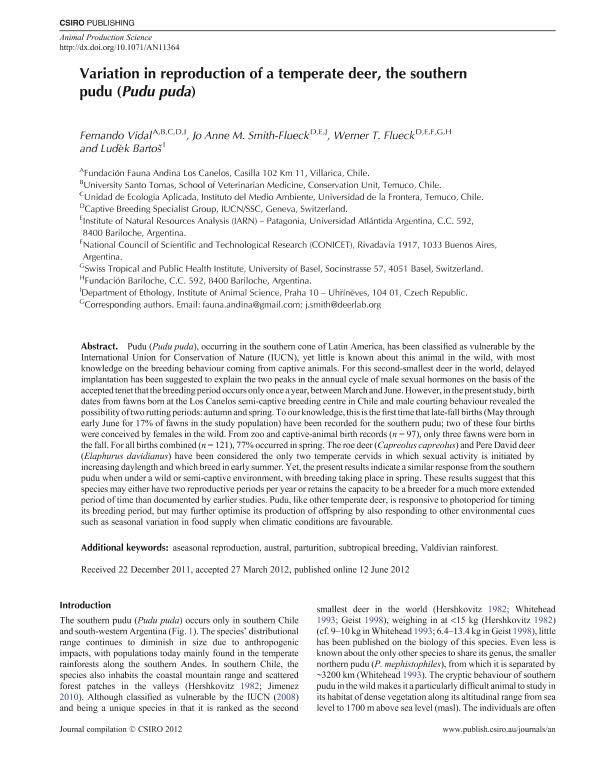Mostrar el registro sencillo del ítem
dc.contributor.author
Vidal, Fernando
dc.contributor.author
Smith-Flueck, Jo Anne M.
dc.contributor.author
Fluck, Werner Thomas

dc.contributor.author
Bartos, Ludek
dc.date.available
2023-05-03T19:43:10Z
dc.date.issued
2012-06
dc.identifier.citation
Vidal, Fernando; Smith-Flueck, Jo Anne M.; Fluck, Werner Thomas; Bartos, Ludek; Variation in reproduction of a temperate deer, the southern pudu (Pudu puda); Csiro Publishing; Animal Production Science; 52; 8; 6-2012; 735-740
dc.identifier.issn
1836-5787
dc.identifier.uri
http://hdl.handle.net/11336/196173
dc.description.abstract
Pudu (Pudu puda), occurring in the southern cone of Latin America, has been classified as vulnerable by the International Union for Conservation of Nature (IUCN), yet little is known about this animal in the wild, with most knowledge on the breeding behaviour coming from captive animals. For this second-smallest deer in the world, delayed implantation has been suggested to explain the two peaks in the annual cycle of male sexual hormones on the basis of the accepted tenet that the breeding period occurs only once a year, between March and June. However, in the present study, birth dates from fawns born at the Los Canelos semi-captive breeding centre in Chile and male courting behaviour revealed the possibility of two rutting periods: autumn and spring. To our knowledge, this is the first time that late-fall births (May through early June for 17% of fawns in the study population) have been recorded for the southern pudu; two of these four births were conceived by females in the wild. From zoo and captive-animal birth records (n = 97), only three fawns were born in the fall. For all births combined (n = 121), 77% occurred in spring. The roe deer (Capreolus capreolus) and Pere David deer (Elaphurus davidianus) have been considered the only two temperate cervids in which sexual activity is initiated by increasing daylength and which breed in early summer. Yet, the present results indicate a similar response from the southern pudu when under a wild or semi-captive environment, with breeding taking place in spring. These results suggest that this species may either have two reproductive periods per year or retains the capacity to be a breeder for a much more extended period of time than documented by earlier studies. Pudu, like other temperate deer, is responsive to photoperiod for timing its breeding period, but may further optimise its production of offspring by also responding to other environmental cues such as seasonal variation in food supply when climatic conditions are favourable.
dc.format
application/pdf
dc.language.iso
eng
dc.publisher
Csiro Publishing

dc.rights
info:eu-repo/semantics/openAccess
dc.rights.uri
https://creativecommons.org/licenses/by-nc-sa/2.5/ar/
dc.subject
ASEASONAL REPRODUCTION
dc.subject
AUSTRAL
dc.subject
PARTURITION
dc.subject
SUBTROPICAL BREEDING
dc.subject
VALDIVIAN RAINFOREST.
dc.subject.classification
Ecología

dc.subject.classification
Ciencias Biológicas

dc.subject.classification
CIENCIAS NATURALES Y EXACTAS

dc.title
Variation in reproduction of a temperate deer, the southern pudu (Pudu puda)
dc.type
info:eu-repo/semantics/article
dc.type
info:ar-repo/semantics/artículo
dc.type
info:eu-repo/semantics/publishedVersion
dc.date.updated
2023-05-03T15:47:10Z
dc.journal.volume
52
dc.journal.number
8
dc.journal.pagination
735-740
dc.journal.pais
Australia

dc.description.fil
Fil: Vidal, Fernando. Universidad de La Frontera; Chile
dc.description.fil
Fil: Smith-Flueck, Jo Anne M.. Universidad Atlantida Argentina; Argentina
dc.description.fil
Fil: Fluck, Werner Thomas. Fundación Bariloche; Argentina. Universidad Atlantida Argentina; Argentina. Consejo Nacional de Investigaciones Científicas y Técnicas; Argentina
dc.description.fil
Fil: Bartos, Ludek. No especifíca;
dc.journal.title
Animal Production Science

dc.relation.alternativeid
info:eu-repo/semantics/altIdentifier/url/https://www.publish.csiro.au/an/AN11364
dc.relation.alternativeid
info:eu-repo/semantics/altIdentifier/doi/http://dx.doi.org/10.1071/AN11364
Archivos asociados
